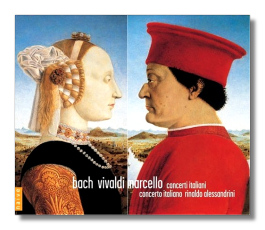
The Internet's Premier Classical Music Source
Related Links
- Latest Reviews
- More Reviews
-
By Composer
-
Collections
DVD & Blu-ray
Books
Concert Reviews
Articles/Interviews
Software
Audio
Search Amazon
Recommended Links
Site News
 CD Review
CD Review
Concerti Italiani

- Benedetto Marcello: Concerto Grosso in E minor, Op. 1 #2
- Alessandro Marcello: Concerto for Oboe in D minor
- Johann Sebastian Bach: Italian Concerto, BWV 971
- Antonio Vivaldi:
- Concerto for 2 Violins and Cello in D minor, Op. 3 #11, RV 565
- Concerto for Violin in G minor, Op. 4 #6, RV 316a
- Concerto for Flute "La notte" in G minor, Op. 10 #2, RV 439
Riccardo Minasi; Antonio de Secondi; Francesca Vicari; Mauro Lopes Ferreira, violin
Luca Peverini, cello
Andrea Mion, oboe
Laura Pontecorvo, flauto traverso
Concerto Italiano/Rinaldo Alessandrini
Opus 111 Naïve OP30301 Sept 2000 Rome 63mins
On the face of things, this is just another album of more or less famous Baroque concertos, but it has a very interesting underlying theme. Each of the concerti by Marcello and Vivaldi was adapted by Johann Sebastian Bach into a work for solo harpsichord. And, to show that turnabout is fair play, Alessandrini has taken Bach's popular Concerto in the Italian Style, a work for solo harpsichord, and turned it into a violin concerto. (This is not as weird as it seems, as many Bach scholars posit that the work might originally have been a violin concerto, now lost). Alessandrini also reconstructed the missing violin obbligato line in the E-minor concerto by Marcello, and that is recorded here too. In other words, this is a CD of prequels.
I'm not wild about Alessandrini's take on the so-called Italian Concerto – its textures are a little thin, and I think it makes a greater impact when it is played on a full-toned harpsichord. Having said that, I must admit that Alessandrini's attempt at backwards-looking musicology is charming and intriguing.
Alessandrini and Concerto Italiano always play mellifluously and with great expression. Sometimes they go a little too far, however. The opening movement of "La Notte," for example, is distorted with very slow tempos and exaggerated silences. (On the other hand, one could argue that the supernatural aspects of this movement are boldly reflected in Alessandrini's interpretation.) The ensemble is small – less than 20 musicians – and appears to be playing on period-style instruments, albeit with a consistently sweet tone. Overall, I can think of more assertive and varied recordings of these concertos, but Alessandrini and his crew will make a positive impression anyway. This is a nice mixed program for those times when you want something a little less demanding than your usual fare.
Patrick Barbier's booklet note goes on at some length about Venice, and its history as the musical capital of Europe circa 1700. These recordings were actually made in Rome between 2000 and 2004. Sonically, they are clean and clear, but somewhat lacking in ambience.
Copyright © 2004, Raymond Tuttle




















